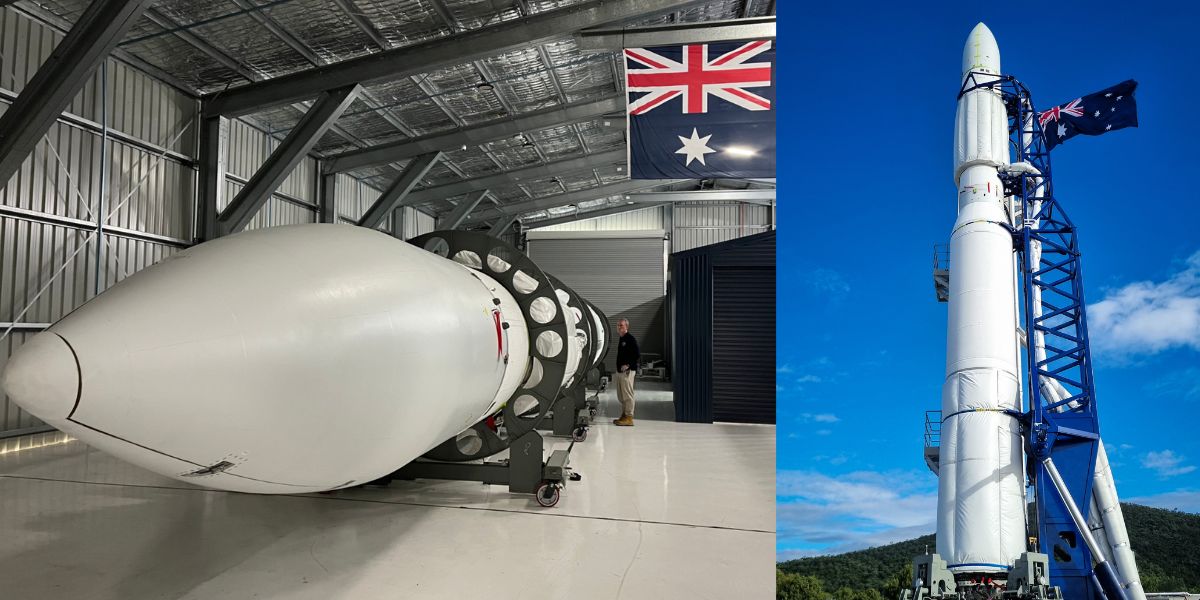primed to host the country’s first-ever homegrown orbital rocket launch this Thursday, May 15. Gilmour Space Technologies is leading the charge with its Eris rocket – a 23.5-metre tall, three-stage behemoth packed with home-designed hybrid propulsion engines.
CEO Adam Gilmour told ARN’s Archie and Donny, “…really busy, but things are going well.” The Eris rocket, named after a dwarf planet beyond Pluto, symbolises the company’s aspirations. “We named it as a destination that we’re going to go for one day,” he added.
Why Bowen?
When asked why Bowen was chosen for such a pivotal mission, Gilmour explained, “It was a location that gave us a lot of orbital opportunities with different inclinations.” Its location also avoids flight paths over densely populated areas and other countries, such as Papua New Guinea and the Solomon Islands. “It was far enough away from the town, but close enough to have resources available.”
The Civil Aviation Safety Authority has cleared the airspace above the site, with a no-fly zone in place for the launch window from 7:30 am to 5:30 pm. Local aviation will be grounded during that time, and the entire launch corridor out to sea is under tight control.

A Symbolic Payload
Although the vehicle is designed to carry payloads of up to 305 kilograms into low Earth orbit, in true Aussie style, a jar of Vegemite will ride along as a symbolic payload. But Gilmour is cautious about expectations:
“Because it’s the first launch attempt, we’re not expecting it to go all the way. As long as it gets off the pad, any flight time is good.”

Despite this being an unmanned mission, Gilmour says crewed spaceflight might not be as far off as people think. “ten years,” he estimated, when asked how long until Australians are launching people into space.
What to Expect on Launch Day
The rocket is programmed to reach a high-altitude orbit of about 180 kilometres, though the true benchmark is velocity. “It’s not about height as much as speed,” said Gilmour. “You have to be going 27,500 kilometres an hour to obtain orbit.” The vehicle weighs 35 tonnes at liftoff.
Unique Rocket Engines
Hybrid rocket engines, like those powering Gilmour Space’s Eris rocket, are a relatively rare choice in modern spaceflight, especially for orbital missions. Unlike conventional liquid or solid engines, hybrids combine a liquid oxidiser with a solid fuel. This design offers enhanced safety since the fuel and oxidiser are stored separately. It also happens to be cheaper and greener than an all-liquid approach.

While a few suborbital systems and experimental rockets have used hybrids, they are virtually unheard of in successful orbital launches due to challenges in achieving responsive thrust and consistent efficiency.
However, according to Space Tech Asia, the team were able to throttle from 10% to 100% with a ‘high level of thrust stability’ during a static test fire.
Gilmour’s approach is notable for attempting to push this underused technology into orbital territory. If a problem occurs during launch, the system can simply shut off the oxidiser flow, terminating the flight without the fiery explosion typical of traditional rockets – thus preserving the launch pad. Instead of a dramatic failure, expect a quiet shutdown and controlled descent, potentially just a heavy thud on return.
Launch Countdown
The lead-up to the launch is just as intense as the event itself. “We’re doing a launch countdown where we do a lot of testing and go through checklists, which includes loading the vehicle up with all the fluids and gases before launch.”, Gilmour explained.

This phase is notorious in the space industry for surfacing last-minute issues. Even in high-budget international missions, problems can arise, like unexpected sensor readings, valve leaks, software faults, or shifts in weather. Any small anomaly can lead to a delay or scrub. The pressure is immense, as systems must work in perfect harmony under tight time constraints. It’s all part of the learning process in Australia’s leap into orbital flight.
7th Operating Nation?
While Australia has previously participated in orbital missions, such as the launch of WRESAT in 1967 from the Woomera Test Range using a modified American Redstone rocket, this will be the first time an Australian-designed and built rocket attempts to reach orbit from Australian soil.
Gilmour Space has invested around $100 million to reach this point, with each rocket costing about $10 million. But the payoff could be enormous. If successful, this launch will position Australia among the select group of nations capable of independently designing, building, and launching orbital rockets from their own territory. It’s a testament to the advancements in Australia’s aerospace industry and its commitment to expanding its presence in space exploration.

Asked whether extraterrestrial contact was something they even prepare for, Gilmour laughed off the idea. “No, it’s not,” he said plainly, before adding with a chuckle, “Look, I believe there’s life out there, but whether we’ve discovered it yet is another story. If aliens landed on the planet and had all this unreal propulsion technology, I’d be out of business, so I kind of hope it doesn’t happen soon!”.
Where To Watch
For those unable to attend in person, Gilmour Space Technologies is expected to provide a live stream of the Eris-1 maiden flight on their official YouTube channel: https://www.youtube.com/@GilmourSpace








